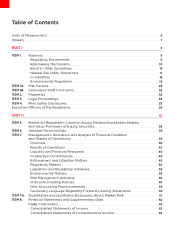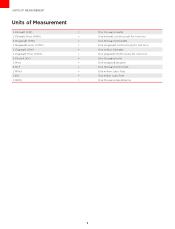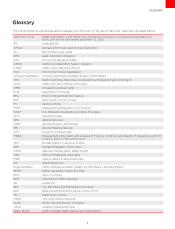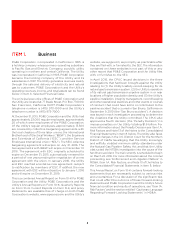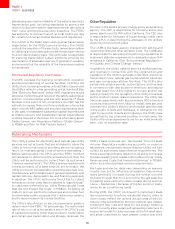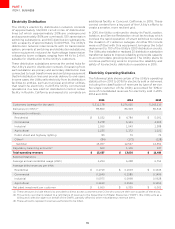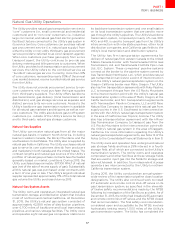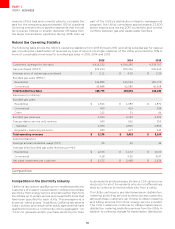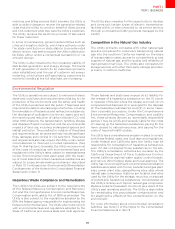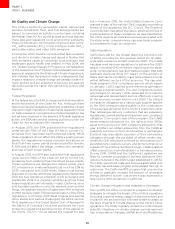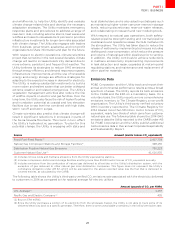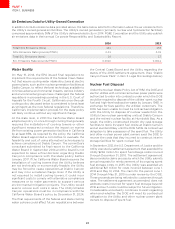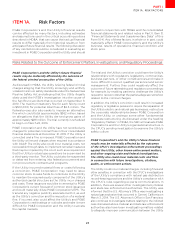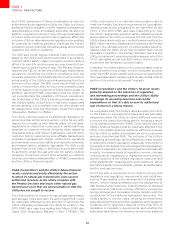PG&E 2015 Annual Report Download - page 22
Download and view the complete annual report
Please find page 22 of the 2015 PG&E annual report below. You can navigate through the pages in the report by either clicking on the pages listed below, or by using the keyword search tool below to find specific information within the annual report.
14
PART I
ITEM1.BUSINESS
Renewable Energy Resources
California law established a “renewable portfolio standard”
(referred to as “RPS”) that requires load-serving entities,
such as the Utility, to gradually increase the amount of
renewable energy they deliver to their customers. In
October 2015, the California Governor signed SB 350,
the Clean Energy and Pollution Reduction Act of 2015
which, eective January 1, 2016, increases the amount of
renewable energy that must be delivered by most load-
serving entities, including the Utility, to their customers
from 33% of their total annual retail sales by the end of
the 2017-2020 compliance period to 50% of their total
annual retail sales by the end of the 2028- 2030 compliance
period and in each compliance period thereafter. SB
350 establishes increasing interim renewable energy
targets for the periods between 2020 and 2030 but also
provides compliance flexibility and waiver mechanisms,
including increased flexibility to apply excess renewable
energy procurement in one compliance period to future
compliance periods. The Utility will incur additional costs
to procure renewable energy to meet the new renewable
energy targets which the Utility expects will continue to
be recoverable from customers as “pass-through” costs.
The Utility also may be subject to penalties for failure to
meet the higher targets. The CPUC has stated its intent
to propose a decision in late 2016 implementing SB 350’s
provisions requiring higher RPS targets and other changes
made by the statute to the RPS rules.
Renewable generation resources, for purposes of the
RPS requirements, include bioenergy such as biogas and
biomass, certain hydroelectric facilities (30 MW or less),
wind, solar, and geothermal energy. During 2015, 29.5%
of the Utility’s energy deliveries were from renewable
energy sources, exceeding the annual RPS target of 23.3%.
Approximately 25% of the renewable energy delivered to
the Utility’s customers was purchased from non-QF third
parties. Additional renewable resources were provided
by QFs (3.0%), the Utility’s small hydroelectric facilities
(0.7%), and the Utility’s solar facilities (0.4%).
The total 2015 renewable deliveries shown above were comprised of the following:
Type GWh PercentofBundledRetailSales
Biopower
Geothermal
Wind
Solar
RPS-EligibleHydroelectric
TOTAL
Energy Storage
As required by California law, the CPUC has established
initial energy storage procurement targets to be achieved
by each load-serving entity, such as the Utility. The Utility
must hold Requests for Oers (RFOs) to meet biennial
targets and procure 580 MW of energy storage which
must be operational by the end of 2024. The Utility’s
2014-2015 energy storage procurement target was
80.5 MW. The Utility initiated its RFO on December 1, 2014
to obtain at least 74 MW of transmission and distribution
connected energy storage, signed contracts for 75 MW,
and submitted those contracts for CPUC approval on
the CPUC’s December 1, 2015 deadline. The Utility met
its remaining 6.5 MW customer-connected target by
funding energy storage under the CPUC-mandated Self
Generation Incentive Program. On January 1, 2016, the Utility
reported its compliance with its 2014-2015 obligations
to the CPUC. The Utility must file its 2016-2017 plan for
procuring 120 MW of energy storage, consisting of 105
MW of transmission and distribution energy storage and
15 MW of customer-connected storage, by March 1, 2016.
A CPUC decision on the Utility’s plan is expected before
the December 1, 2016 deadline for the Utility to issue
its second energy storage RFO. The Utility continues to
participate in the CPUC proceeding to refine California’s
energy storage program, which is considering potentially
higher targets and expanded energy storage use cases.


